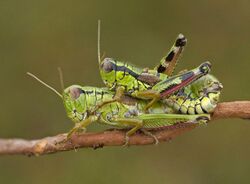Biology:Acridoidea
| Acridoidea | |
|---|---|

| |
| Miramella alpina | |
| Scientific classification | |
| Domain: | Eukaryota |
| Kingdom: | Animalia |
| Phylum: | Arthropoda |
| Class: | Insecta |
| Order: | Orthoptera |
| Suborder: | Caelifera |
| Infraorder: | Acrididea |
| Informal group: | Acridomorpha |
| Superfamily: | Acridoidea MacLeay, 1821[1] |
| Families | |
|
See Classification. | |
| Synonyms | |
| |
Acridoidea is the largest superfamily of grasshoppers in the order Orthoptera with species found on every continent except Antarctica.[2]
Classification
Orthoptera Species File includes the following families:[2]
- Acrididae MacLeay, 1821
- Dericorythidae Jacobson & Bianchi, 1905
- Lathiceridae Dirsh, 1954
- Lentulidae Dirsh, 1956
- Lithidiidae Dirsh, 1961
- Ommexechidae Bolívar, 1884
- Pamphagidae Burmeister, 1840
- Pamphagodidae Bolívar, 1884
- Pyrgacrididae Kevan, 1974
- Romaleidae Pictet & Saussure, 1887
- Tristiridae Rehn, 1906
Chromosomes
Among the families Acrididae, Ommexechidae and Romaleidae there is reported to be chromosomal stability with a high frequency of species harbouring diploid number (2n) of 23♂/24♀ chromosomes.[3][4] In species of Acrididae and Romaleidae it is common to have acrocentric chromosomes with a fundamental number (FN), i.e. number of chromosome arms, of 23♂/24♀.[4] However, chromosomal rearrangements are frequently found as deviations from the standard acrocentric karyotype. In the subfamily Ommexechinae most species show a unique karyotype (2n = 23♂/24♀, FN = 25♂/26♀) due to the occurrence of a large autosomal pair (L1) with submetacentric morphology.[4] There is some support for 'Mesa's hypothesis' of an ancestral pericentric inversion in the ancestor of Ommexechinae to explain this karyotype variation.[5][6][4][7]
References
- ↑ MacLeay WS (1821) Horae Entomologicae or Essays on the Annulose Animals (from www.biodiversitylibrary.org originally as "Acridina").
- ↑ 2.0 2.1 Cigliano, M. M.; Braun, H.; Eades, D. C.; Otte, D.. "superfamily Acridoidea MacLeay, 1821". Orthoptera Species File. http://orthoptera.speciesfile.org/Common/basic/Taxa.aspx?TaxonNameID=1102979.
- ↑ G. M. Hewitt (1979). "Insecta 1: Orthoptera. Grasshoppers and crickets". Animal cytogenetics 3. Berlin: Gebrüder Borntraeger.
- ↑ 4.0 4.1 4.2 4.3 A. Mesa; A. Ferreira; C. S. Carbonell (1982). "Cariología de los acridoideos neotropicales: estado actual de su conocimiento y nuevas contribuciones". Annales de la Société Entomologique de France 18: 507–526.
- ↑ A. Mesa (1963). "Acerca de la cariología de Ommexechidae (Orthoptera-Acridoidea)". Revista de la Sociedad Uruguaya de Entomología 5: 37–43.
- ↑ A. Mesa; A. Ferreira (1977). "Cytological studies in family Ommexechidae (Orthoptera-Acridoidea)". Acrida 6: 261–271.
- ↑ Santander, Mylena D.; Cabral-de-Mello, Diogo C.; Taffarel, Alberto; Martí, Emiliano; Martí, Dardo A.; Palacios-Gimenez, Octavio M.; Castillo, Elio Rodrigo D. (2021). "New insights into the six decades of Mesa's hypothesis of chromosomal evolution in Ommexechinae grasshoppers (Orthoptera: Acridoidea)". Zoological Journal of the Linnean Society 193 (4): 1141–1155. doi:10.1093/zoolinnean/zlaa188. https://academic.oup.com/zoolinnean/article/193/4/1141/6138200.
Wikidata ☰ Q1097755 entry
 |


